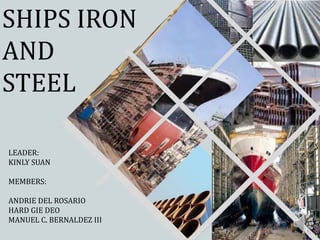
Pig iron production process
- 1. SHIPS IRON AND STEEL LEADER: KINLY SUAN MEMBERS: ANDRIE DEL ROSARIO HARD GIE DEO MANUEL C. BERNALDEZ III
- 2. • Pig iron • also known as • (crude iron) • is the product of smelting iron ore (also ilmenite) with a high- carbon fuel and reductant such as coke, usually with limestone as a flux. Charcoal and anthracite are also used as fuel and reductant. THE PRODUCTION OF PIG IRON
- 3. •(Pig iron is produced by smelting or iron ore in blast furnaces or by smelting ilmenite in electric furnaces). •It can be used as a raw material for iron steel making and most of this material was imported.
- 4. What is the product of iron made from iron ore? • The production of iron from its ore involves a redox reaction carried out in a blast furnace.
- 5. • hematite (Fe2O3) • magnetite (Fe3O4) • limestone (CaCO3) THERE ARE 3 TYPES FILLED AT THE TOP
- 6. 4.2 EXPLAIN THE ELEMENTS THAT NATURALLY OCCUR IN IRON AND ITS EFFECT ON MECHANICAL PROPERTY. How does iron occur naturally? • In the Earth's crust iron is found mainly as minerals of iron oxide such as hematite, magnetite, goethite and limonite. The minerals that are mostly used as ore for making iron are: • Hematite • Magnetite • Iron is quite soft and easily worked, but it has a very high melting point of 1538°C.
- 7. What is the key element that influences the properties of iron? • To improve the characteristics of iron, alloying elements are added to it so that it can be used commercially. Elements like manganese, sulfur, silicon and phosphorus are added to iron. What are the element properties of iron? • Iron is a lustrous, ductile, malleable, silver-gray metal (It is known to exist in four distinct crystalline forms.) What are the factors affecting mechanical properties of iron/metal? • The mechanical properties of metal are generally determined by a number of factors, including grain size, heat treatment, atmospherics exposure, and temperature.
- 8. 4.3 EXPLAIN THE PROCESS INVOLVED IN STEELMAKING Steel is made primarily in a two-step process. In the primary steelmaking step, liquid iron is converted into steel by the basic oxygen furnace (BOF) process, or by melting scrap steel or direct reduced iron (DRI) in an electric arc furnace. What is the process in steelmaking? • Steelmaking are mined and then transformed into steel using two different processes: the blast furnace/basic oxygen furnace route, and the electric arc furnace route. Both processes are being continually improved to meet the challenge of low-emission steelmaking.
- 9. Which steelmaking process is the most common type? • EAF method • is the most common steel making process today. Today's modern EAF steelmaking furnaces produce 150 tons of steel per melt, which takes approximately 90 minutes. • Bessemer process • was the first inexpensive industrial process for the mass production of steel from molten pig iron before the development of the open hearth furnace. The key principle is removal of impurities from the iron by oxidation with air being blown through the molten iron.
- 10. 4.4 EXPLAIN THE CATEGORIES OF WROUGHT STEELS WITH EMPHASIS OF FOLLOWING: A. PLAIN CARBON STEEL is a steel with carbon content from about 0.05 up to 2.1 percent by weight. Carbon steel is a popular metal choice for knife-making due to its high amount of carbon, giving the blade more edge retention. To make the most out of this type of steel it is very important to heat treat it properly. If not, the knife may end up being brittle, or too soft to hold an edge.
- 11. B. LOW ALLOY STEEL is a type of metal mixture composed of steel and another metals that possess desirable properties. Low-alloy steel contains about 1%-5% of alloying elements. Therefore, it possesses precise chemical compositions that provide better mechanical properties that are intended to prevent corrosion.
- 12. C. HIGH ALLOY STEEL High-alloy steels are usually called stainless steels. They are known for high levels of corrosion resistance. Stainless steels used for pressure vessels and piping construction are divided into three groups: •Austenitic stainless steels consist of chromium-nickel (300 series) and chromium-nickel-manganese (200 series). •Ferritic stainless steels are straight chromium stainless steels with a minimum of 10% chromium. They are nonhardenable by heat treatment. •Martensitic stainless steels contain 11% to 16% chromium with sufficient carbon to be hardenable (less than 1%). They are hardenable by heat treatment.
- 13. HIGH ALLOY STEEL
- 14. D. ALLOYING LIMITS FOR LOW ALLOY STEELS Low-alloy steel contains about 1%-5% of alloying elements. Therefore, it possesses precise chemical compositions that provide better mechanical properties that are intended to prevent corrosion.